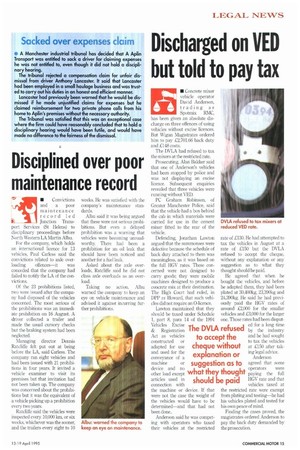Discharged on VED but told to pay tax
Page 17

If you've noticed an error in this article please click here to report it so we can fix it.
• Concrete mixer ellicle operator David Anderson, trading as Spotmix RMC, has been given an absolute discharge on three offences of using vehicles without excise licences. But Wigan Magistrates ordered him to pay .E2,701.66 back duty and £148 costs.
The DVLA had refused to tax the mixers at the restricted rate.
Prosecuting, Alan Bakker said that one of Anderson's vehicles had been stopped by police and was not displaying an excise licence. Subsequent enquiries revealed that three vehicles were running without VED.
PC Graham Robinson, of Greater Manchester Police, said that the vehicle had a box behind the cab in which materials were carried for use in the cement mixer fitted to the rear of the vehicle.
Defending, Jonathan Lawton argued that the summonses were defective because the schedule of back duty attached to them was meaningless, as it was based on the full HGV rates. These concerned were not designed to carry goods; they were mobile machines designed to produce a concrete mix at their destination. The High Court had ruled, in DPP vs Howard, that such vehicles did not require an 0-licence.
Lawton maintained that they should be taxed under Schedule 1, part 8, para. 14 of the 1994 Vehicles Excise ez Registration Act as vehicles constructed or adapted for use and used for the conveyance of a
machine or device and no other load except articles used in connection with the machine or device. If that were not the case the weight of the vehicles would have to be determined—and that had not been done..
Anderson said he was competing with operators who taxed their vehicles at the restricted
Air!,
•
rate of £130. He had attempted to tax the vehicles in August at a rate of £150 but the DVLA refused to accept the cheque, without any explanation or any suggestion as to what they thought should be paid.
He agreed that when he bought the vehicles, and before he adapted them, they had been plated at 30,400kg, 23,390kg and 24,390kg. He said he had previously paid the HGV rates of around £2,000 for the smaller vehicles and £3,000 for the larger one. Those rates had been disputed for a long time by the industry and he had sought to tax the vehicles at £150 after taking legal advice.
Anderson agreed that some operators were paying the full HGV rate and that vehicles taxed at the testi icted rate were exempt from plating and testing—he had his vehicles plated and tested for his own peace of mind.
Finding the cases proved, the magistrates ordered Anderson to pay the back duty demanded by the prosecution.
































































































